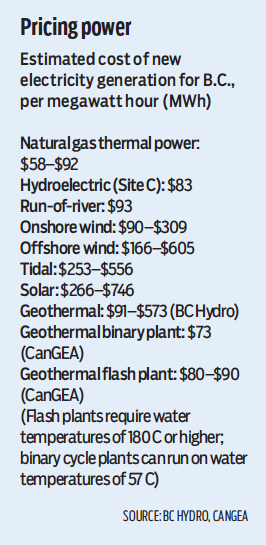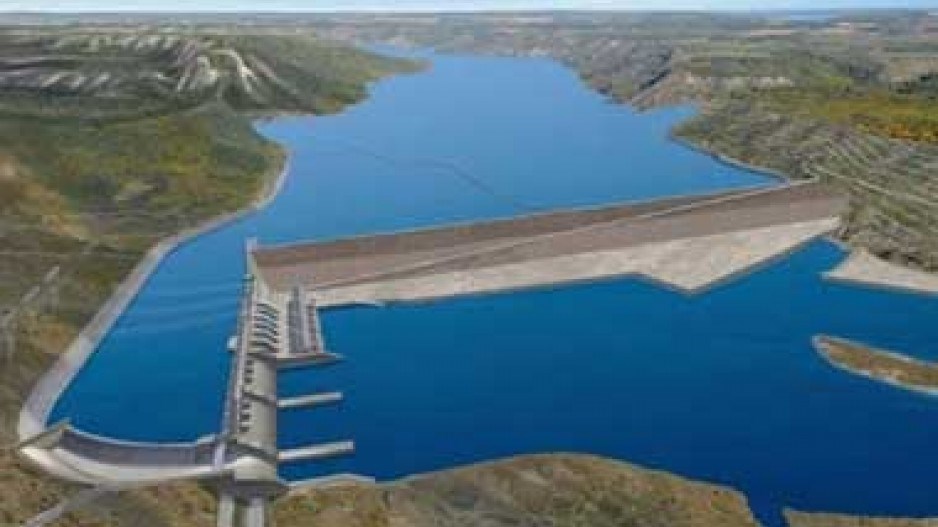Before the B.C. government approves the $8 billion Site C dam, it should consider new mapping and data that demonstrate an equivalent amount of power could be generated for $3.3 billion from geothermal power, and with a much smaller environmental footprint, says the Canadian Geothermal Energy Association (CanGEA).
The B.C. government plans to make a final decision on Site C before Christmas. CanGEA has asked for a one-year moratorium on that decision so the B.C. government, BC Hydro and the BC Utilities Commission can study a report CanGEA produced in response to what its author said is outdated data that was used to dismiss geothermal as too expensive.
“What would be wrong with that?” asked Paul Kariya, executive director for Clean Energy BC. “For the sake of ratepayers and taxpayers, take a little bit of time.
“I think it behooves government and BC Hydro to look at some of these options.”
According to the report’s author, CanGEA managing director Alison Thompson, a panel that reviewed Site C relied on out-of-date information. New “unconventional” geothermal sources have been identified in northeastern B.C. by the oil and gas sector, for example.
Her report came out the day after Geoscience BC issued a request for proposals to “high-grade” 18 known geothermal sites, which could reduce some of the upfront costs associated with the exploration side of the geothermal business.
The oil and gas industry appears to have done some of the heavy lifting for geothermal developers such as Alberta-based Borealis GeoPower, which Thompson co-founded.
“They’ve already drilled, they’ve already found the water, they’ve already found the temperatures,” Thompson said. “So they’ve already done all the exploration.”
B.C. is known to have potentially productive geothermal assets, and geothermal energy does have some distinct advantages over other energy sources. One is its small environmental footprint, compared with dams or wind farms. More importantly, it is firm power.
Once hot underground aquifers are tapped, the heat can be used to drive turbines to generate a steady supply of electricity, unlike intermittent power (wind, solar and hydro, for example). The heat from the water can also be used to heat buildings or greenhouses.
CanGEA estimates geothermal power in B.C. could generate 5,100 gigawatt hours of electricity per year (equal to Site C) for $73 per megawatt hour (MWh), compared to Site C’s $83 per MWh.
Unfortunately for geothermal developers, building a plant isn’t the only cost. Finding a productive, economically viable geothermal source can be a costly hit-and-miss process, with a single test well costing $4 million or more.
“The problem with these is that it’s very risky and you’ve got to go out there and spend a lot of capital to prove a resource that may provide nothing,” said Randy Reimann, BC Hydro’s director of resource planning.

He is skeptical about the estimates CanGEA came up with. BC Hydro estimates geothermal power would cost a minimum of $91 per MWh to build. Reimann also points out that in its last clean-power call, none of the submissions it received were for geothermal projects.
Some work has been done in the past to identify potential geothermal sites in B.C., but Geoscience BC now plans to “high-grade” those sites and do some economic modelling to identify which, if any, are economically viable to develop.
“What we want to try to do is take it to the next level so that British Columbians can have an informed dialogue on geothermal energy,” said Carlos Salas, vice-president of oil and gas for Geoscience BC.
“We want to make sure that, at the end of the day, all British Columbians understand what truly is economically viable and what is just pie in the sky.”
Salas said the analysis should be done by the end of April 2015.




